Despite using what could look like relatively simple construction and technology, tyres are without doubt among the most critical and complex areas of a race car. They are surely one of the most important elements in defining its performance and dynamic behaviour.
Tyres are what put the cars in connection to the road and therefore the means through which every action between vehicle and track is exchanged. If a car’s tyres don’t work properly, there’s no way to extract the maximum possible performance out of the package.
In this series of articles, we will try to scratch the surface about how tyres work, and the most important functions they carry out. Of course, there is much more about tyres than what we can describe here and there is also much that tyres manufacturers keep secret, being part of their critical know how.
Our goal is to help the readers who don’t know much about tyres to get a better picture about why they are so important and, maybe, to give the opportunity to more informed readers to review some known concepts.
Tyres as a vertical spring
From a purely mechanical perspective, a tyre is a composite structure mainly made out of rubber and metal reinforcements. They are approximately toroidal shaped, opened on the lower side where the rim is mounted.
The details about the construction of a tyre’s main structure determine most of its most important features, and influence heavily how the tyre itself behaves and performs. This is a major reason why tyre manufacturers invest more energy and resources in terms of development.
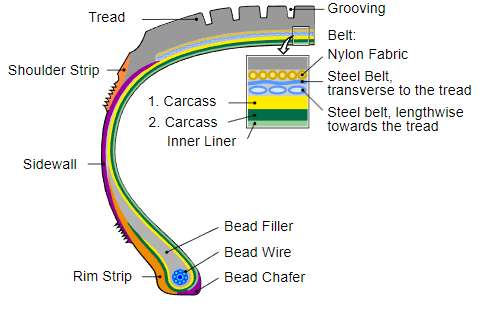
The volume between tyre’s structure and rim is filled with gas (normally simply air). This gas is stored inside the available volume with a certain pressure and this contributes, together with the tyre structure, to absolve one of the most basic function of a pneumatic tyre: absorbing the loads coming from outside, reacting with a certain stiffness (stiffness = load needed to deflect the tyre of one millimetre).
In this sense, a tyre can be seen as a spring, with a different stiffness depending on the relative direction in which the loads are applied. Limiting our analysis to the vertical direction, each tyre will have a certain stiffness that directly depends on its inflating pressure, with a higher pressure producing an higher stiffness. The relationship between tyre pressure and stiffness depends on many factors, mostly related to tyre design, and is normally non-linear.
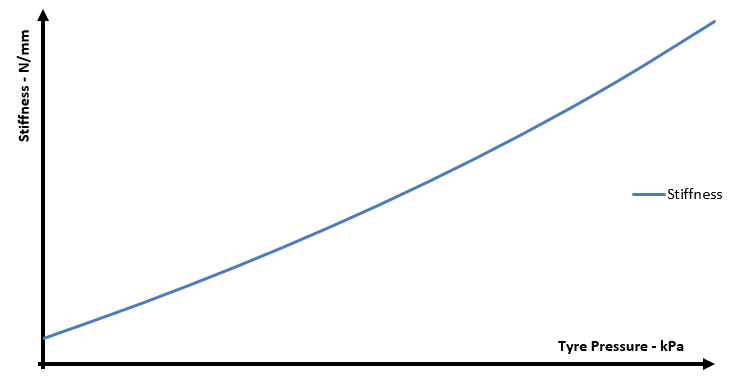
Vertical stiffness has a very important role in defining tyre behaviour and performance. It determines how the tyres contribute to the axle (or car quarter) suspension vertical stiffness. This is central in defining how the car reacts to the road surface, and how much the ride heights change with vertical loads — for example, because of downforce.
A tyre can be considered as a spring in series with suspension wheel rate, isolating the unsprung mass from the ground. This can be investigated by using a quarter car model.
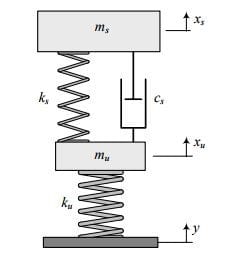
Ms is corner’s sprung mass. The sprung mass can be identified by weighting the car with four scales, each below one of the four wheels. We will have to subtract the weight of the unsprung mass Mu from what we read on the scale to obtain Ms. The unsprung mass is the weight of wheels, brakes, uprights, hubs, bearings, etc, i.e all the components seating “below” the spring, including a portion of the control arms.
Ks is suspension vertical stiffness, Cs is its damping coefficient and Ku is the unsprung mass stiffness (tyre stiffness). How the car moves vertically with respect to the ground depends on the stiffness series Ks and Ku.
Contact patches
Tyre stiffness also significantly influences the shape that the tyre's contact patch assumes under load.
The tyre contact patch is the area where the tyre comes into contact with the ground. As the tyre is not a rigid body, this area’s dimensions change depending on loads and on tyre stiffness.
As many readers with a driving licence will know, tyre pressures that are too high cause tyre deformation. This reduces the dimensions of the contact area and increases wear in the central section of the tread. If a tyre is inflated too much, its volume increases in vertical direction, affecting the overall tyre shape and leading to a kind of “donut” shape.
On the other hand, tyre pressures that are too low allow the tyre deform more and tend to increase the wear on the sides of the tread.
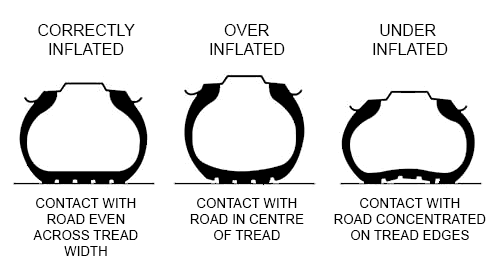
Beside these two extreme behaviours, what is more interesting for race cars is that tyre vertical stiffness determines how large the contact patch area is in each situation. It also defines its shape, and how that shape changes during cornering, braking, and how it reacts to tyre inclination (camber).
As we will see, contact patch area and shape is central in defining the magnitude of the forces that the tyres can exchange with the road surface. This then impacts how quick a car can negotiate a corner, or how hard it can brake or accelerate.
Tyre stiffness also defines how high local pressure acting on tread surface is, as contact area dimensions, loads and pressure are all linked together.
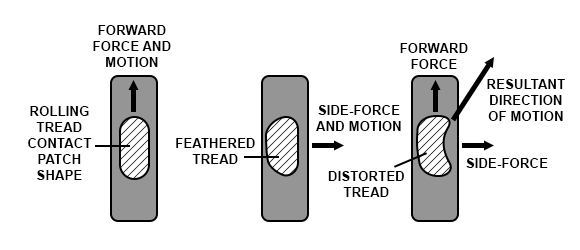
One effect also connected to tyre stiffness and pressure is tyre expansion with speed. Because of the centrifugal forces acting on every small portion of its structure, tyre diameter tends to increase with rotating speed and, consequently, the tyre’s contact patch tends to become smaller and longer.
This effect counteracts the vertical forces — downforce and weight — that squat the tyres. For example, in LMP cars, where the aerodynamic downforce is generally very big, and also for GT cars, this becomes more and more important as the speed increases. Keep in mind, too, that aerodynamic forces depends on the square of the speed.
How much the tyre diameter expands with rotational velocity depends very much on the design and materials used to build the tyre carcass. Generally, in cars with significant downforce, the vertical forces that act on the tyres are stronger than the centrifugal effect: the tyres normally experience a diameter reduction and an increasingly bigger contact patch dimension as the speed grows. This phenomenon is not as strong as it would be without tyre centrifugal expansion.
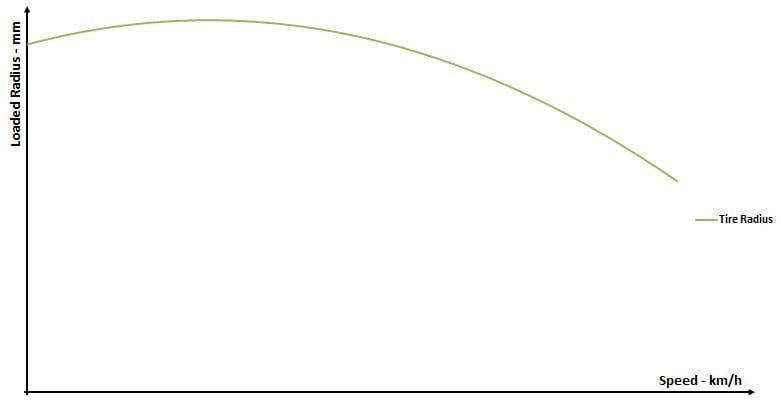
Rolling resistance
Also connected to tyre vertical dynamics and stiffness is rolling resistance. Rolling resistance is a very important parameter for road tyres, since it is strictly connected to fuel consumption.
As the name pretty much explains, rolling resistance is the force that tends to slow down the wheel as it rolls on a surface. The car experiences this force as a something that tends to slow its forward movement. It's an action that takes place at the contact patches, as it is a force exerted by the ground on the car.
Rolling resistance is not as important for race cars as it is for road cars, since its magnitude is normally pretty small compared to the aerodynamic drag, which is an aerodynamic force that also brakes the cars, acting against its forward movement. Still, it can normally be quantify as a small percentage of the vertical load acting on the tyre. So, in a car with significant downforce, it also increases as the speed increases — because, as we know, downforce squares with speed.
The causes of rolling resistance are in tyre deformations as it gets into contact with the road during its rotation. To each deformation is associated a certain loss of energy, as the material composing the threads produces some hysteresis.
Moreover, tyre contact patch experiences a non-symmetric pressure distribution, as the tread come into contact with the road during wheel’s rotation. The result is that the vertical force applied by the ground to the tyre has its application point seating slightly forward compared to contact patch’s centre, thus producing a sort of braking moment.
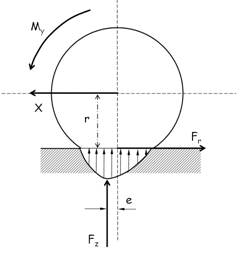
A stiffer tyre normally produces less rolling resistance than a less stiff one and, in general, increasing the inflating pressure normally reduces rolling resistance. The graph below shows the coefficient of rolling resistance as a function of speed, for a road tyre. The coefficient of rolling resistance is defined as following:

Fx being the forward force of the vehicle, Fz the upward force from the ground.
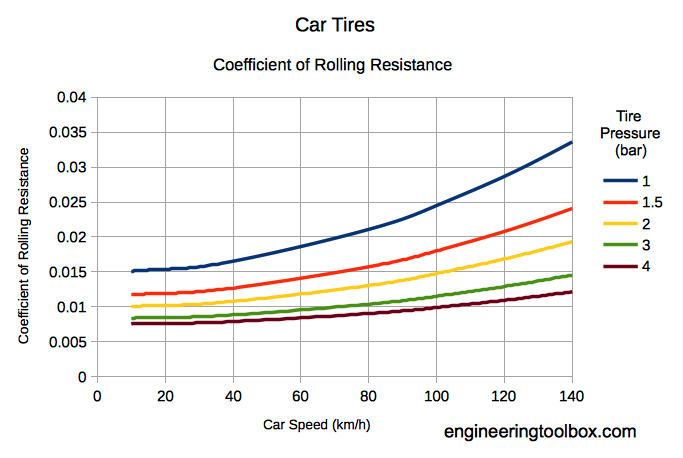
Next week, in part 2, we'll discuss road interaction.
